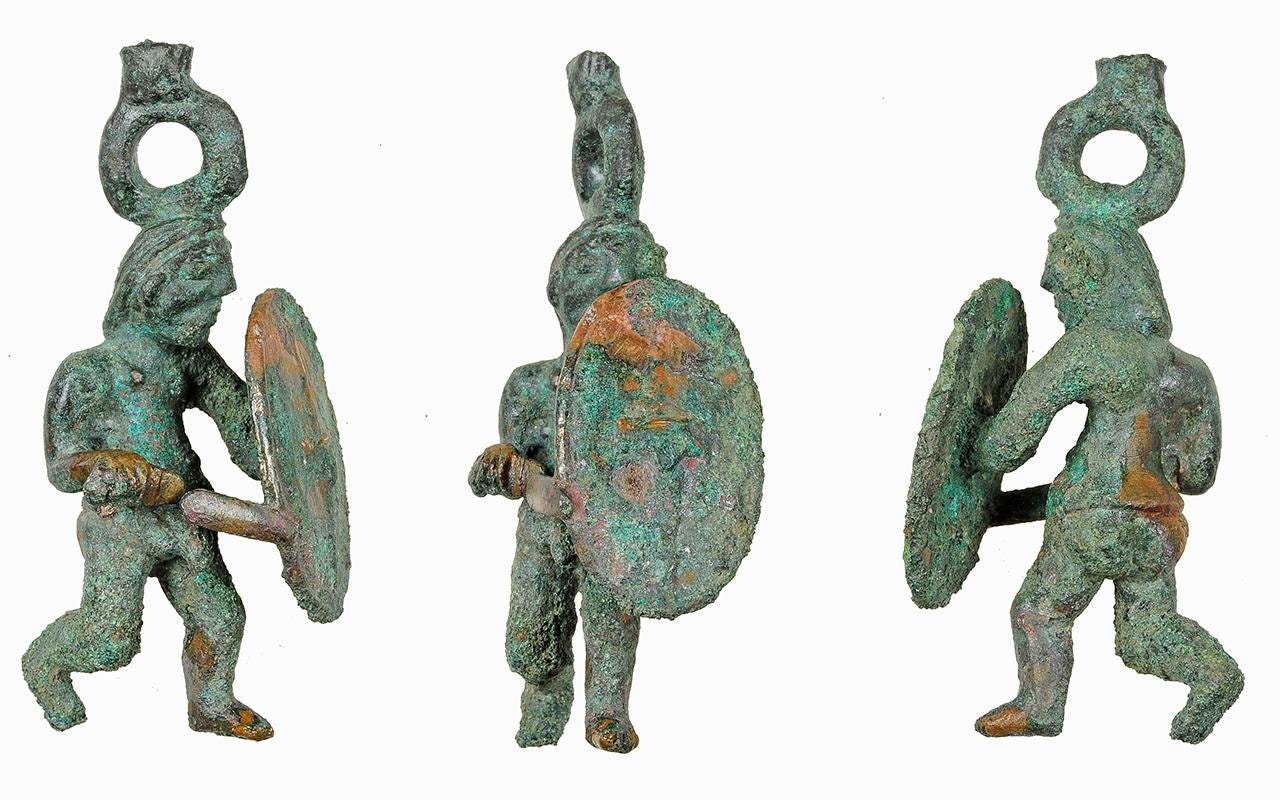🧐 Ancient Beat #163: Domestication, the earliest bows and arrows, and a Celtic payday
Hello, friends! Let’s all enjoy a brief sojourn into the ancient world, shall we?
Here’s the latest ancient news. 👇
🗞 Ancient News: Top 5
40,000 Celtic Artifacts and Rare Bronze Warrior Figurine Unearthed at Manching in Bavaria — Excavations at the Iron Age oppidum of Manching in Bavaria uncovered over 40,000 artifacts, including a 3-inch-tall (7.5 cm), 2-ounce (55 g) bronze figurine of a warrior in a lunging stance, bearing sword and shield. Made using the lost-wax casting technique, the figurine is intricately detailed and possibly worn as a pendant. The site also yielded 15,000 metal objects, ritual deposits with human and animal remains, fish bones (a first for the site), and evidence of urban planning with homes and workshops. Occupied from the late 4th to mid-1st century BCE, Manching reached 400 hectares and may have supported 10,000 people, making it one of the largest Celtic centers north of the Alps. The discovery sheds light on diet, craft, ritual, and sociopolitical complexity in late Iron Age Europe.
Earliest Proof of Neanderthals, Homo Sapiens Interbreeding Discovered By Israeli Archaeologists — A child’s skull from Skhul Cave in Israel—excavated around 90 years ago—was digitally reexamined using micro‑CT scanning and 3D modeling. The morphology reveals a modern human–style cranial vault alongside Neanderthal-like inner ear structure and jaw features, indicating interbreeding between the two groups roughly 140,000 years ago. If confirmed, this would represent the oldest known physical evidence of hybridization, reshaping views on early coexistence between these hominins.
Were Arrows Flying in Central Asia 80,000 Years Ago? — Excavations in Uzbekistan’s Obi‑Rakhmat cave have produced 80,000‑year‑old micro‑point stone tools—tiny triangular flakes about 0.7 inches wide and under 1 gram each. Microscopic wear and experimental tests (using a 36‑lb laminated bow on small game) show fractures mirroring archaeological specimens, strongly suggesting these were arrow‑like projectile tips. This pushes back the emergence of bow‑and‑arrow technology (from ~64,000 BP) well into the Middle Paleolithic and suggests complex hunting strategies among early hominins in Central Asia. I love a good pushing-back-the-date story. 🤓
Sculptures Pulled From Sacred Spring In Kashmir Valley — In Aishmuquam, Kashmir Valley, 21 carved stone sculptures and relief fragments were retrieved from a sacred spring during renovation work. Among them were 11 shivlings and several possible hero stones or commemorative stelas honoring warriors, ascetics, or women who died by ritual self-sacrifice. The artistic motifs blend Hindu and Buddhist elements, pointing to a time of religious coexistence during the Karkota Dynasty (circa 625–855 CE). The artifacts suggest the spring was once part of a now-vanished shrine with ritual significance.
Roots of Domestication: How Ancient Farmers and Shifting Environments Shaped Maize Beneath the Soil — In Mexico’s Tehuacán Valley, a region with one of the world’s oldest records of maize domestication, researchers reconstructed how maize root systems evolved over 9,000 years in response to both human cultivation and environmental change. They found that maize progressively developed fewer shallow (nodal) roots, more deep‑penetrating dense tissue (multiseriate cortical sclerenchyma), and more early‑emerging seminal roots. Shifts in root traits correlate with rising CO₂ levels (12,000–8,000 years ago), later irrigation (around 6,000 years ago), and soil depletion with agricultural intensification (by 3,500 years ago). This subterranean story adds crucial context to the plant‑human relationship in ancient agriculture.
That’s it for the free Top 5! If you’re a free subscriber, sign up for the paid plan for another 26 discoveries and 4 recommended pieces of content covering temples, tools, tides, and digitally-unwrapped prayer scrolls.
Until next time, thanks for joining me!
-James
Twitter: @jamesofthedrum
P.S. Here’s my Buy Me A Coffee link if you’d like to support my efforts with a donation.
P.P.S. If you want access to the paid version but it’s a little too steep for you right now, just email me — I want this to be accessible.
P.P.P.S. Paid members, read on!
🗞 Ancient News: Deep Dive
Keep reading with a 7-day free trial
Subscribe to Ancient Beat to keep reading this post and get 7 days of free access to the full post archives.


